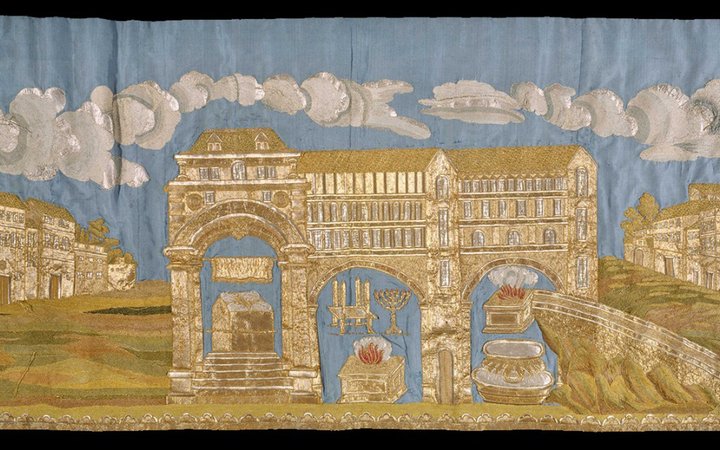The exhibition explores the history of Italy's Jewish community from a novel and very colourful angle, that of textile art.
Some 140 exhibits, including tapestries, textiles, decorative fabrics, lace work, clothing, paintings and other everyday or religious items, present the history of Italy's Jewish community for the first time through one of the lesser-known arts, that of weaving, which has always played a crucial role in the decoration of houses, palaces and places of worship in the Jewish world. The show offers key insight into both the treasured traditions and the joyful, colourful side of a culture rich in symbols, and explores its intercultural, international outlook, expressed in the outstanding variety of motifs featured, where colour often takes centre stage.
Taking us from the ancient world right up to the fashions of the twentieth century and modern textile manufacturing, the exhibits explore key themes such as the use of writing as a decorative motif, synagogue textiles, embroidery carried out in secret, and the role of women. Significant even in Biblical times, textiles have been used to express the Jewish identity up to recent days, as can be seen from a number of absolute masterpieces, many from the Middle and Far East, that Italy's Jews came into contact with through family or trading ties. See, for instance, the spectacular Ottoman curtain (or parochet) woven in the first quarter of the sixteenth century, on loan from the Museo della Padova Ebraica.
Visitors to the exhibition will be able to admire several extremely rare pieces from foreign museums and collections, which offer a sort of tour of the calendar of Jewish festivities. These include embroidered fragments from the Museum of Fine Arts in Cleveland and two curtains from the Jewish Museum in New York and the Victoria and Albert Museum in London which, together with those from Florence, form a triptych of furnishing fabrics similar in terms of both technique and symbology, on display here together for the very first time.
The oldest fabrics on show in the exhibition, datable to the fifteenth century, include a curtain for the Torah ark from the Museo Ebraico di Roma, another from the Synagogue in Pisa and a textile panel from the ‘Badia Fiorentina hanging’ which originally adorned the walls of the church on solemn feast days. All these fabrics are in tooled velvet interwoven with gold thread and feature the "griccia" motif, namely a pomegranate on a sinuous stem, which may well be the textile design that best symbolises the Renaissance in Tuscany.
The embroidery is simply breathtaking, some depicting "canting arms" (because Jews were prohibited from receiving noble titles) in sumptuous Baroque frames. Authentic “paintings in needlework" that would have glittered in the flickering light of candles and torches, a triumph of vibrant silks and gold and silver thread, these pieces were produced by the skilled hands of women, a display of astounding creativity and encyclopaedic knowledge.
The shows closes with an absolute masterpiece, a piece of lace some eight metres long designed by Lele Luzzati for the ocean liner Oceanic.It is a collage of ancient and modern pieces that reproduces The Splendour and Images of Italy's Commedia dell'Artein an unusual medium that combines traditional craftsmanship with astonishing artistic creativity.
The Colours of Judaism in Italy
Precious fabrics from the Temple of Jerusalem to contemporary ready-to-wear
Aula Magliabechiana - The Uffizi
27 June 2019 - 27 October 2019


